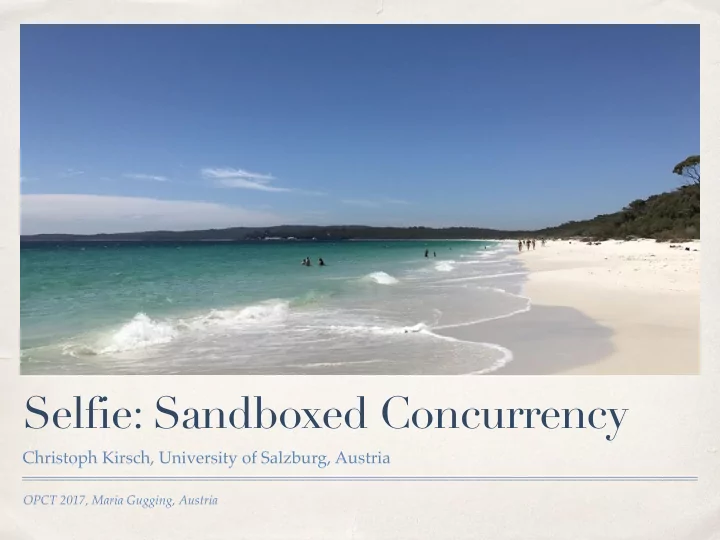

Selfie: Sandboxed Concurrency Christoph Kirsch, University of Salzburg, Austria OPCT 2017, Maria Gugging, Austria
Joint Work ✤ Alireza Abyaneh ✤ Martin Aigner ✤ Sebastian Arming ✤ Christian Barthel ✤ Michael Lippautz ✤ Cornelia Mayer ✤ Simone Oblasser
Inspiration ✤ Armin Biere: SAT Solvers ✤ Donald Knuth: Art ✤ Jochen Liedtke: Microkernels ✤ David Patterson: RISC ✤ Niklaus Wirth: Compilers
Teaching Computer Science from First Principles!
What is the meaning of this sentence? Selfie as in self-referentiality
Interpretation Translation Teaching the Construction of Semantics of Formalisms Virtualization Verification
Selfie: Teaching Computer Science [selfie.cs.uni-salzburg.at] ✤ Selfie is a self-referential 7k-line C implementation (in a single file) of: 1. a self-compiling compiler called starc that compiles a tiny subset of C called C Star (C*) to a tiny subset of MIPS32 called MIPSter, 2. a self-executing emulator called mipster that executes MIPSter code including itself when compiled with starc, 3. a self-hosting hypervisor called hypster that virtualizes mipster and can host all of selfie including itself, 4. a tiny C* library called libcstar utilized by all of selfie, and 5. a tiny, experimental SAT solver called babysat .
Website selfie.cs.uni-salzburg.at Book (Draft) leanpub.com/selfie Code github.com/cksystemsteaching/selfie
Discussion of Selfie recently reached 3rd place on Hacker News news.ycombinator.com
nsf.gov/csforall code.org computingatschool.org.uk programbydesign.org bootstrapworld.org k12cs.org csfieldguide.org.nz
int atoi(int *s) { no data types other 5 statements: int i; than int and int* assignment int n; and dereferencing: while int c; the * operator if i = 0; return n = 0; procedure() character literals c = *(s+i); string literals while (c != 0) { n = n * 10 + c - '0'; if (n < 0) return -1; i = i + 1; integer arithmetics no bitwise operators c = *(s+i); pointer arithmetics no Boolean operators } return n; } library: exit , malloc , open , read , write
Scarcity versus Abundance If you want structs implement them!
> make cc -w -m32 - D 'main(a,b)=main(a, char **argv)' selfie.c -o selfie bootstrapping selfie.c into x86 selfie executable using standard C compiler (now also available for RISC-V machines)
> ./selfie ./selfie: usage: selfie { -c { source } | -o binary | -s assembly | -l binary } [ ( -m | -d | -y | -min | -mob ) size ... ] selfie usage
> ./ selfie -c selfie.c ./ selfie: this is selfie's starc compiling selfie.c ./ selfie: 176408 characters read in 7083 lines and 969 comments ./ selfie: with 97779(55.55%) characters in 28914 actual symbols ./ selfie: 261 global variables, 289 procedures, 450 string literals ./ selfie: 1958 calls, 723 assignments, 57 while , 572 if , 243 return ./ selfie: 121660 bytes generated with 28779 instructions and 6544 bytes of data compiling selfie.c with x86 selfie executable ( takes seconds )
> ./ selfie -c selfie.c -m 2 -c selfie.c ./ selfie: this is selfie's starc compiling selfie.c ./ selfie: this is selfie's mipster executing selfie.c with 2MB of physical memory selfie.c: this is selfie's starc compiling selfie.c selfie.c: exiting with exit code 0 and 1.05MB of mallocated memory ./ selfie: this is selfie's mipster terminating selfie.c with exit code 0 and 1.16MB of mapped memory compiling selfie.c with x86 selfie executable into a MIPSter executable and then running that MIPSter executable to compile selfie.c again ( takes ~6 minutes )
> ./ selfie -c selfie.c -o selfie1.m -m 2 -c selfie.c -o selfie2.m ./ selfie: this is selfie's starc compiling selfie.c ./ selfie: 121660 bytes with 28779 instructions and 6544 bytes of data written into selfie1.m ./ selfie: this is selfie's mipster executing selfie1.m with 2MB of physical memory selfie1.m: this is selfie's starc compiling selfie.c selfie1.m: 121660 bytes with 28779 instructions and 6544 bytes of data written into selfie2.m selfie1.m: exiting with exit code 0 and 1.05MB of mallocated memory ./ selfie: this is selfie's mipster terminating selfie1.m with exit code 0 and 1.16MB of mapped memory compiling selfie.c into a MIPSter executable selfie1.m and then running selfie1.m to compile selfie.c into another MIPSter executable selfie2.m ( takes ~6 minutes )
Sandboxed Concurrency: 1-Week Homework Assignment Formalism Formalism Formalism Compiler Compiler Compiler Emulator Emulator || Emulator Emulator Emulator Emulator Machine Machine Machine
> ./ selfie -c selfie.c -m 2 -c selfie.c -m 2 -c selfie.c compiling selfie.c with x86 selfie executable and then running that executable to compile selfie.c again and then running that executable to compile selfie.c again ( takes ~24 hours )
Emulation versus Virtualization Formalism Formalism Formalism Compiler Compiler Compiler Emulator Hypervisor Emulator Emulator Emulator Machine Machine Machine
> ./ selfie -c selfie.c -m 2 -c selfie.c -y 2 -c selfie.c compiling selfie.c with x86 selfie executable and then running that executable to compile selfie.c again and then hosting that executable in a virtual machine to compile selfie.c again ( takes ~12 minutes )
“How do we introduce self-model-checking and maybe even self-verification into Selfie?” https://github.com/cksystemsteaching/selfie/tree/vipster
SMT Solver SAT Solver What is the absolute simplest way of proving non-trivial properties of Selfie using Selfie? Bounded Model Checker Inductive Theorem Prover
Emulation Machine Context Emulator Unshared Program Context
Virtualization Machine Context Hypervisor Shared Machine Context
Proof Obligation ? Machine Context Machine Context = Emulator Hypervisor
Hybrid of Emulator & Hypervisor Machine Context ! Emulation Virtualization OR Hybrid Machine Context
Validation of Functional Equivalence? Machine Context ? Emulation Virtualization AND Hybrid Machine Context
Verification of Functional Equivalence? Machine Context ? = Emulation Virtualization Hybrid Machine Context
Questions ✤ What are the benefits of the hybrid design in Selfie? ✤ Will these benefits change the design of real kernels, that is, is the hybrid design realistic? ✤ Can we develop C* into a useful specification language, cf. ACL2? ✤ Can we prove interesting properties with a, say, ~10k-line system? ✤ Will this help teaching rigorous systems and software engineering at bachelor level? ✤ Will this help identifying basic principles that can be taught to everyone?
Thank you!
Recommend
More recommend